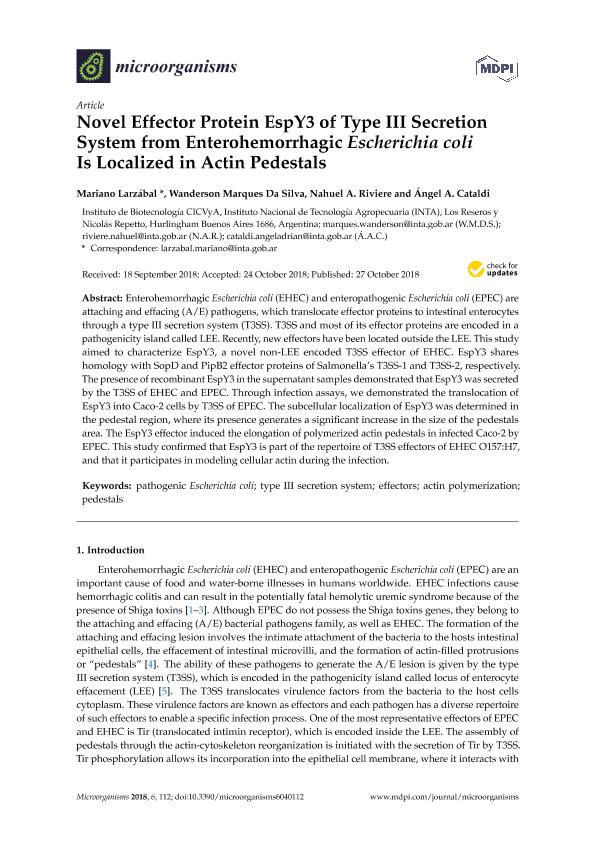Mostrar el registro sencillo del ítem
dc.contributor.author
Larzabal, Mariano

dc.contributor.author
Marques Da Silva, Wanderson

dc.contributor.author
Riviere, Nahuel Agustín

dc.contributor.author
Cataldi, Ángel Adrián

dc.date.available
2022-11-14T16:06:13Z
dc.date.issued
2018-10
dc.identifier.citation
Larzabal, Mariano; Marques Da Silva, Wanderson; Riviere, Nahuel Agustín; Cataldi, Ángel Adrián; Novel Effector Protein EspY3 of Type III Secretion System from Enterohemorrhagic Escherichia coli Is Localized in Actin Pedestals; MDPI; Microorganisms; 6; 4; 10-2018; 1-8
dc.identifier.issn
2076-2607
dc.identifier.uri
http://hdl.handle.net/11336/177691
dc.description.abstract
Enterohemorrhagic Escherichia coli (EHEC) and enteropathogenic Escherichia coli (EPEC) are attaching and effacing (A/E) pathogens, which translocate effector proteins to intestinal enterocytes through a type III secretion system (T3SS). T3SS and most of its effector proteins are encoded in a pathogenicity island called LEE. Recently, new effectors have been located outside the LEE. This study aimed to characterize EspY3, a novel non-LEE encoded T3SS effector of EHEC. EspY3 shares homology with SopD and PipB2 effector proteins of Salmonella’s T3SS-1 and T3SS-2, respectively. The presence of recombinant EspY3 in the supernatant samples demonstrated that EspY3 was secreted by the T3SS of EHEC and EPEC. Through infection assays, we demonstrated the translocation of EspY3 into Caco-2 cells by T3SS of EPEC. The subcellular localization of EspY3 was determined in the pedestal region, where its presence generates a significant increase in the size of the pedestals area. The EspY3 effector induced the elongation of polymerized actin pedestals in infected Caco-2 by EPEC. This study confirmed that EspY3 is part of the repertoire of T3SS effectors of EHEC O157:H7, and that it participates in modeling cellular actin during the infection.
dc.format
application/pdf
dc.language.iso
eng
dc.publisher
MDPI
dc.rights
info:eu-repo/semantics/openAccess
dc.rights.uri
https://creativecommons.org/licenses/by/2.5/ar/
dc.subject
ACTIN POLYMERIZATION
dc.subject
EFFECTORS
dc.subject
PATHOGENIC ESCHERICHIA COLI
dc.subject
PEDESTALS
dc.subject
TYPE III SECRETION SYSTEM
dc.subject.classification
Biología Celular, Microbiología

dc.subject.classification
Ciencias Biológicas

dc.subject.classification
CIENCIAS NATURALES Y EXACTAS

dc.title
Novel Effector Protein EspY3 of Type III Secretion System from Enterohemorrhagic Escherichia coli Is Localized in Actin Pedestals
dc.type
info:eu-repo/semantics/article
dc.type
info:ar-repo/semantics/artículo
dc.type
info:eu-repo/semantics/publishedVersion
dc.date.updated
2022-11-14T15:32:55Z
dc.journal.volume
6
dc.journal.number
4
dc.journal.pagination
1-8
dc.journal.pais
Suiza

dc.description.fil
Fil: Larzabal, Mariano. Instituto Nacional de Tecnología Agropecuaria. Centro de Investigación en Ciencias Veterinarias y Agronómicas. Instituto de Biotecnología; Argentina. Consejo Nacional de Investigaciones Científicas y Técnicas; Argentina
dc.description.fil
Fil: Marques Da Silva, Wanderson. Instituto Nacional de Tecnología Agropecuaria. Centro de Investigación en Ciencias Veterinarias y Agronómicas. Instituto de Biotecnología; Argentina. Consejo Nacional de Investigaciones Científicas y Técnicas; Argentina
dc.description.fil
Fil: Riviere, Nahuel Agustín. Instituto Nacional de Tecnología Agropecuaria. Centro de Investigación en Ciencias Veterinarias y Agronómicas. Instituto de Biotecnología; Argentina. Consejo Nacional de Investigaciones Científicas y Técnicas; Argentina
dc.description.fil
Fil: Cataldi, Ángel Adrián. Instituto Nacional de Tecnología Agropecuaria. Centro de Investigación en Ciencias Veterinarias y Agronómicas. Instituto de Biotecnología; Argentina. Consejo Nacional de Investigaciones Científicas y Técnicas; Argentina
dc.journal.title
Microorganisms
dc.relation.alternativeid
info:eu-repo/semantics/altIdentifier/url/http://www.mdpi.com/2076-2607/6/4/112
dc.relation.alternativeid
info:eu-repo/semantics/altIdentifier/doi/http://dx.doi.org/10.3390/microorganisms6040112
Archivos asociados
